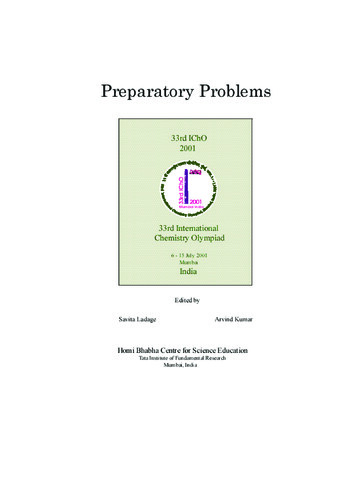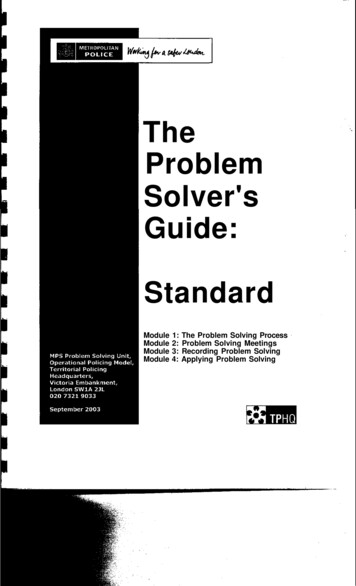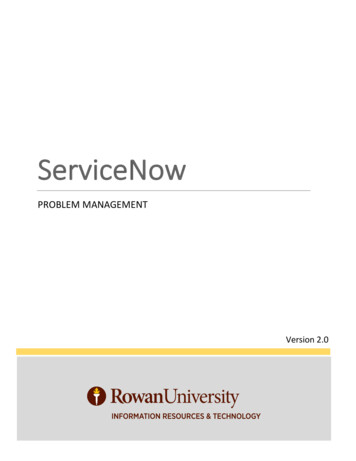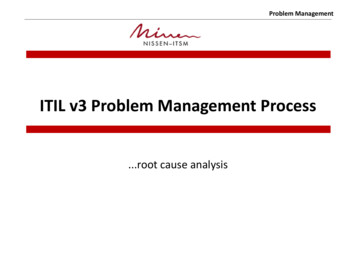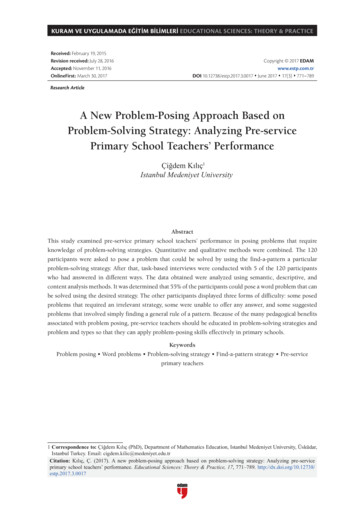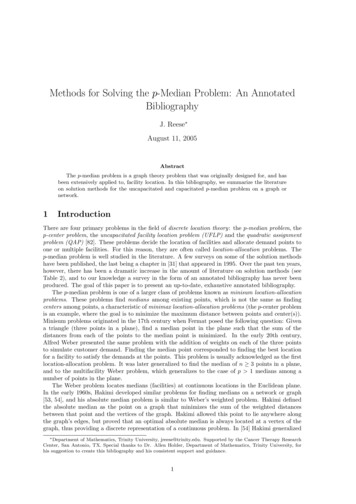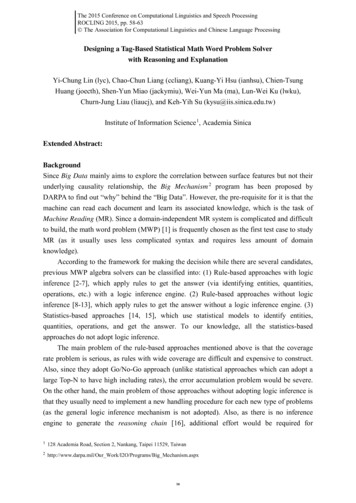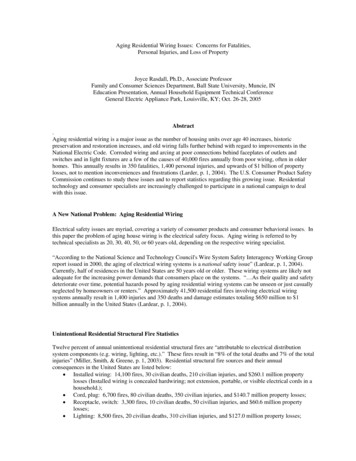
Transcription
Aging Residential Wiring Issues: Concerns for Fatalities,Personal Injuries, and Loss of PropertyJoyce Rasdall, Ph.D., Associate ProfessorFamily and Consumer Sciences Department, Ball State University, Muncie, INEducation Presentation, Annual Household Equipment Technical ConferenceGeneral Electric Appliance Park, Louisville, KY; Oct. 26-28, 2005Abstract.Aging residential wiring is a major issue as the number of housing units over age 40 increases, historicpreservation and restoration increases, and old wiring falls further behind with regard to improvements in theNational Electric Code. Corroded wiring and arcing at poor connections behind faceplates of outlets andswitches and in light fixtures are a few of the causes of 40,000 fires annually from poor wiring, often in olderhomes. This annually results in 350 fatalities, 1,400 personal injuries, and upwards of 1 billion of propertylosses, not to mention inconveniences and frustrations (Larder, p. 1, 2004). The U.S. Consumer Product SafetyCommission continues to study these issues and to report statistics regarding this growing issue. Residentialtechnology and consumer specialists are increasingly challenged to participate in a national campaign to dealwith this issue.A New National Problem: Aging Residential WiringElectrical safety issues are myriad, covering a variety of consumer products and consumer behavioral issues. Inthis paper the problem of aging house wiring is the electrical safety focus. Aging wiring is referred to bytechnical specialists as 20, 30, 40, 50, or 60 years old, depending on the respective wiring specialist.“According to the National Science and Technology Council's Wire System Safety Interagency Working Groupreport issued in 2000, the aging of electrical wiring systems is a national safety issue” (Lardear, p. 1, 2004).Currently, half of residences in the United States are 50 years old or older. These wiring systems are likely notadequate for the increasing power demands that consumers place on the systems. “ As their quality and safetydeteriorate over time, potential hazards posed by aging residential wiring systems can be unseen or just casuallyneglected by homeowners or renters.” Approximately 41,500 residential fires involving electrical wiringsystems annually result in 1,400 injuries and 350 deaths and damage estimates totaling 650 million to 1billion annually in the United States (Lardear, p. 1, 2004).Unintentional Residential Structural Fire StatisticsTwelve percent of annual unintentional residential structural fires are “attributable to electrical distributionsystem components (e.g. wiring, lighting, etc.).” These fires result in “8% of the total deaths and 7% of the totalinjuries” (Miller, Smith, & Greene, p. 1, 2003). Residential structural fire sources and their annualconsequences in the United States are listed below: Installed wiring: 14,100 fires, 30 civilian deaths, 210 civilian injuries, and 260.1 million propertylosses (Installed wiring is concealed hardwiring; not extension, portable, or visible electrical cords in ahousehold.); Cord, plug: 6,700 fires, 80 civilian deaths, 350 civilian injuries, and 140.7 million property losses; Receptacle, switch: 3,300 fires, 10 civilian deaths, 50 civilian injuries, and 60.6 million propertylosses; Lighting: 8,500 fires, 20 civilian deaths, 310 civilian injuries, and 127.0 million property losses;
Panel board, meter, transformer: 3,300 fires, 20 civilian deaths, 40 civilian injuries, 48.4 million inproperty losses;Other: 3,900 fires, 20 civilian deaths, 130 civilian injuries, and 97.1 million property losses; andTotal electrical distribution system: 39,800 fires, 180 civilian deaths, 1,090 civilian injuries, and 733.9 million in property losses (Miller, Smith, & Greene, 2003).Table 1Annual unintended residential structural fires and their consequences in the United StatesElectrical itemInstalled wiringCord, plugReceptacle, switchLightingPanel board, meter,transformerOtherTotal elec. DistributionsystemNo. of an deathsCivilians injuries30801020 2021035050310 40Property 1801301,09097.1 733.9These losses drive up insurances rates, and the costs of fire protection in communities, and endanger firemen’slives.Residential technology educators understand the differences between conductors and insulators, howevertypical homeowners and students do not typically grasp the principles and consequences involved. Mosthomeowners and students flip a light switch on or off, casually plug in new electrical appliances they purchase,and if there is no open outlet, they add an extension cord or power strip. Furthermore, “electrical wiringsystems that power the conveniences of modern life are hidden in walls and in panel boxes in basements. Theyare out of sight and out of mind. But that does not mean they are not overloaded and under severe stress”(Lardear, p. 1, 2004).Residences Wired in the 1960s or EarlierAccording to the United States Consumer Product Safety Commission, homes over 40 years of age are thegreater risk, “but newer ones can have dangers of unacceptable wiring practices and environmental stresses ontheir wiring” (CPSC, 2005). Residential wiring systems installed in new or existing houses during the 1960sand earlier are almost surely at the end of their functional design life. “These products are showing some kindof deficiency after 50 or 60 years of service” (Lardear, p. 1, 2004). The housewiring poses hidden but realdangers. “According to the United States Census Bureau's 1999 Annual Housing Survey, there are 70 millionhomes (or 71% of all housing units) that are at least 20 years old and they aren't getting any younger. In somerespects, just by making a casual observation of older houses, you can understand why these fires are continuingto occur” (Lardear, p. 1, 2004).In general, annual residential fires are going down because of better electrical codes, smoke alarms, and firesuppression systems. Thus, homes constructed today do not “face the same problems as the majority of the 100million existing homes in the United States” (Lardear, p.1, 2004). Unfortunately, however, electrical wiringfires sustained by older residences that are especially vulnerable to the issues of aging wiring and overloadedelectrical circuits, are not parallel to this downward trend.
Bill King, engineer at the U.S. Consumer Product Safety Commission (CPSC, 2004), indicates that if safetyproponents do not deal with the issue of older residences and the inherent aging wiring systems, then the fire,fatality, injuries, and property losses have great potential for catastrophe. Homeowners generally upgradeconstruction components including roofs, windows, furnaces, and even electrical circuit breaker boxes or fusepanels. However, the remainder of the electrical wiring system is out of sight and unfortunately out of mind alltoo often. Wiring concealed in walls and their branch circuits are typically neglected and hardly ever arereplaced (Lardear, p. 1, 2004).Primary Residential Wiring Safety IssuesThe growing problems related to aging residential wiring systems are due to the following parameters:1.Cumulative effects of a variety of environmental stresses and the wear and tear of daily electricaluses impact life expectancy of residential wiring. The severity of aging of wiring depends on avariety of factors.A. Degradation of conductors increases with age.a) Oxidation/corrosion films can cover conductors, especially at connections.b) Excess heat from overlamped light fixtures causes brittle conductors.c) Conductor technology had little or no innovation during the last 30 years. Themost recent major innovation in residential wiring occurred in 1985 when “therequired maximum temperature rating of nonmetallic cable was increased to 90degrees C while keeping the ampacity to 60 degrees C,” resulting in an effectivepractice (Lardear, p. 1, 2004).d) Conductor connections can loosen or even disconnect with time, thus setting upa situation for sparking/arcing if electrical current is to flow when the consumerturns on a switch. “Sometimes switches can come loose from the wall, and themovement of the wiring back and forth can break connections, damage insulation,or make bare wires touch metal. Any one of these can cause a fire" (USCPSC,2004).e) Connections in electrical outlets, switches, light fixtures, and the like can loosendue to a variety of reasons.i.Expansion and contraction due to temperature changes seasonally and daily;ii.Vibrations from trains, sonic booms from jet aircraft, other noisy vehicles,high decibel level music/radio equipment, and thunder;iii.Wind and air pressure changes are also causes; and/oriv.The frequency and or unnecessary use of the switch.B. Deterioration of insulation occurs over time.a) Heat from overlamped light fixtures and other installations heavily loadedelectrically and light cause deterioration and accelerate loss of plasticizer ininsulation (Lardear, 2005).b) Dry locations lead to loss of the plasticizer in PVC insulation. Drying isdependent on length of time and high temperature factors as well (Lardear, 2005).c) Water absorption into insulation in wet locations reduces its insulative strength(Lardear, 2005).d) Rodents and other creatures can damage insulation over the years.2.If older wiring during add-on wiring jobs is disturbed then safety risks result from crackingbrittle insulation. In fact, some electricians operate with a policy that 30-year-old wiring bereplaced because assessing how badly aging has damaged the wiring is difficult at best.
3.Increased kilowatt hour use involves most residential consumers owning and using moreappliances and lighting than consumers used 40, 50, and 60 years ago. They expect the electricalsystem to provide adequate electricity for their growing electrical demands. Consumers make thisdemand operational by adding more circuits (and circuit breakers in blank spots on the breakerpanel, or even another circuit breaker box) and outlets to accommodate their purchases. If anoutlet is added to an existing circuit, then the load can easily be more than the wiring was designedto conduct originally—perhaps decades ago.4.Peak consumer/residential energy use occurs twice daily (reflected in household energy usepatterns from 6 to 8 a.m. and 5 to 8 p.m.), in most U.S. utility systems and consumer households,thus leading to major stress and safety risks on aging wiring systems during these hours. Ifconsumers could level out the peaks, then risks associated with high KWH use could be mediatedsomewhat.5.Small wiring [number 14 American Wire Gauge (AWG)] began to be disallowed by selectedlocal codes during the 1960s in favor of larger 12 AWG. By about 1970, the National ElectricCode changed to 12 AWG, thus making the older standard out of date regarding increasing KWHuse and peaks. Unless wiring has been upgraded since 1970, then homes are probably wired withsmall wiring for common branch circuits.6.Too often unskilled homeowners engage in additions to circuits resulting in installations that donot meet the National Electrical Code (either then or currently) and/or are not inspected by aqualified electrical inspector when finished. Do-it-yourselfers can create serious violations of thecode, causing accidents waiting to happen.7.Too often consumers do not know or do not want to engage in managing aging wiring systems.Maintenance and inspection can be expensive and time-consuming and technically challenging.“As the first step to addressing this issue, the National Fire Protection Association developedNFPA 73, which differs from NFPA 70 by providing requirements for evaluating existingelectrical systems” (Lardear, 2004). During the sale of a home, a prospective owner might makecertain that the house conforms to NFPA 73 before completing the sale, thus overcoming the mostcommon and risky hazards of an aging wiring system.8.According to the CPSC (2004), “an estimated 2 million homes and mobile homes were wired withaluminum wire” between 1965 and 1974 in the United States. This wiring used 15 and 20ampere circuits of size 10 AWG or smaller and aluminum wiring in wall outlets, switches, circuitbreakers, fuse sockets, and lamp sockets connected to the wiring. “In 1974, the CPSC determinedthat hazards associated with aluminum wire systems” were “unreasonable risk(s) of injury ordeath” and filed suit charging two dozen aluminum wire manufacturers. The CPSC indicates thathomes wired with aluminum wiring manufactured before 1972 (old technology aluminum wire)are 55 times more likely” to sustain connections that reach Fire Hazard Conditions in contrast to
homes with copper wiring. In 1972, manufacturers modified aluminum, including switches andoutlets, to enhance performance at connections—where aluminum wiring problems are—sincealuminum wiring is fine. “ Aluminum expands and contracts three times the rate of copper,likely eventually creating a gap at wiring connections, causing both sparks and oxidation ofaluminum ends”(Lardear, 2004). Oxidation fosters electrical resistance and elevated heat levels inthe circuit. Oxidized aluminum is a poor conductor and acts as an insulator in elevated heatenvironments, a precursor to hazardous arcs and glowing red connections (Electrical SafetyFoundation International, 2003).9.Other results from aging residential wiring systems beyond the safety hazards are theinconveniences, either potential or realized when fire disasters occur. Psychological costs,personal injuries, fatalities, and property losses are difficult to sustain and involve a variety ofmonetary and temporal costs with daily living patterns, employment during disasters, and otherissues. Inconveniences of aging wiring can involve questionable practices of using extensioncords, power strips, and even unplugging a device to plug in another. Aging wiring typicallyinvolves few or no exterior outlets and few outlets in kitchen and other task areas.10. Covering wiring rated for open use is an issue. Covering wiring with attic insulation can cause afire hazard in attics and other concealed spaces. If insulation is added to a house, then any wiringor fixtures covered with insulation must be certified/rated for such conditions (USCPSC, 2004).11. Lack of safety improvements over the years that are now required in the National Electric Codeinclude Ground Fault Circuit Interrupters (GFCIs) and Arc Fault Circuit Interrupter (AFCI).Having at least 5 feet between an outlet and a bathtub may be violated in older wiring.Arc faults: a Growing Safety issueAn arc fault is commonly called a spark. An arc fault is “a discharge of electric current across a gap” betweenelectrical conductors. “In a home, arc faults can be years or just seconds in the making. Arc faults can be causedby a variety of factors including loose or improper connections to outlets or switches; cracked wire insulationstemming from age, heat, or corrosion; and electrical wire insulation chewed by rodents or punctured by nails.”Arcs are particularly dangerous in walls and ceilings since temperatures of 10,000 degrees F or above can ignitewood easily. The CPSC (2004) estimates, fires starting with electrical distribution systems amounts to morethan 10 percent of all home fires, partially because of arc faults. “Since household fuses and circuit breakers donot respond to early arcing and sparking conditions, in January 2002, the National Electrical Code (1999 NFPA70, Section 210-12), began requiring Arc Fault Circuit Interrupters (AFCIs) for all branch circuits supplying125V, single phase, 15- and 20-ampere outlets for bedroom circuits in new residential construction” (Lardear, p.1, 2004). Scorched areas around faceplates and circuit breaker or fuse panels can mean sparking or overloaded,inadequate wiring that could ignite paper, fabric fibers, and/or wood nearby (USCPSC, 2004).Thus, AFCIs and their capacity to identify unique electrical current and voltage characteristics are probablymore important for deteriorated aging wiring systems. AFCIs sense arcs and sparks in wiring at receptacles andswitches. AFCIs have capabilities beyond that of fuses and circuit breakers, particularly for deactivating arc
faults hidden in walls and ceilings. AFCIs are unique from Ground Fault Circuit Interrupters (GFCI) thatprotect against shock (dangerous overcurrent flow). Both GFCIs and AFCIs deactivate a circuit, but eachprotects a unique cause, dangerous power surges/shorts or arcs and sparks at wiring connections at receptaclesand switches respectively.The CPSC and the National Fire Protection Association have worked together to require arc fault detectiondevices in new and retrofit construction (USCPSC, September 2000). The 2002 edition of the National ElectricCode specifies Arc Fault Circuit Interrupters in bedrooms in order to reduce risks among consumers whilesleeping (National Fire Protection Association, 2005). The 2005 edition adds AFCIs to within a few feet of thecircuit breaker panel in order to protect from sparks in that vicinity. More AFCI provisions are underconsideration for future editions.Aging Residential Wiring Safety Educational CampaignsA partnership of the National Fire Protection Association’s (NFPA) Fire Protection Research Foundation withseveral other groups is a major educational campaign (Lardear, 2004). In May 2003, the Electrical SafetyFoundation International (ESFI) initiated its "Inspect and Protect!" program to spur homeowners to engage aqualified, licensed electrician to inspect wiring systems in homes 40 years and older, to learn about the potentialhazards posed by aluminum wiring systems and to consider installing AFCI technology (Electrical SafetyFoundation International, 2003).Implications for Consumer Educators and Residential Technology SpecialistsEncouraging consumers to maintain house wiring, just as a car, furnace, roof, or chimney needs maintenance iscritical. Establishing priorities for first and then second maintenance/updates is a functional step (USCPSC,2004). Asking consumers to check with the respective insurance agent to ascertain if wiring safetyimprovements qualify the policy holder for a premium reduction is a recommendation.Aging residential wiring issues pose serious implications to consumer educators and residential technologyspecialists. How will these professionals/educators deal with this growing problem? Residential technologyeducators are challenged to1.2.3.4.Engage in curriculum upgrades that involve aging house wiring issues,Develop resources and reference list with strategic data,Develop class learning experiences with speakers and tours focusing on aged wiring issues, andIncorporate student real world projects such as that described below.Old wiring needs to be abandoned and replaced. The consequences of not upgrading old wiring areclear, can be formidable, and need to be addressed among students preparing for careers in ResidentialTechnology and related Family and Consumer Sciences Programs.Residential Technology Student ProjectExperiential learning is enhanced by students in an Interior Design studio 2 course at the sophomore levelcompleting a project with one to five owners or occupants of aging housing, depending on the percentage of thefinal grade the project represents. Students identify their contacts and use the implications section outlinedabove to structure their own interview outline. Each student uses the section following for questions and
priority issues addressed in this project in order to identify consumers’ real world experiences with thiselectrical safety issue. A summary of each interview/site is reported separately in outline format by the student.Lastly, an overall summary and analysis is synthesized by each student.Objectives for the project include1.2.3.4.To investigate current aging residential wiring/electricity use and practices for safety concerns.To discuss aging wiring issues and their consequences with occupants.To examine occupant awareness and understanding of aging wiring recommendations.To summarize findings from occupants in each residence and synthesize recommendations as for bestpractice and electrical safety of the occupants.Students gain greater insights from on-site, in-person interviews than through only the lecture and classdiscussion prior to the field experience. Many students are interested in do-it-yourself residential upgrades andrestorations and thus through this project they gain increased human capital for decision-making personally andfor professional consultations in their future careers. Thus, this project enables students to gain ownership oftheir careers, rather than only learning on the sidelines.Questions and Priority Issues for Consumer and Student Consideration1.2.3.4.5.6.7.8.9.10.11.12.13.List the causes of hazards of aging residential wiring.Cite the consequences of aging residential wiring issues.What visible evidences are there in and outside the home of aging wiring practices?What problems do the occupants report regarding dysfunctions of aging wiring?What improvements have the occupants made with the aging wiring, if any?What plans and timetable for improvements do the occupants report, if any?What recommendations should we propose among Do-It-Yourselfers?What implications are there for historic preservation, restoration, and retrofits of homes, offices orretail space or other adaptive reuse,When a home constructed prior to 1960 is sold, will the buyer have it electrically inspected by acompetent, licensed electrician or inspector?Based on the consumer’s experiences with wiring in an older home, what recommendations doeshe/she propose if she/he were to move/relocate?Unless the residence is rewired, will it have an electrical inspection as a part of responsible electricalsystem management? If no, cite reasons; if yes, cite reasons.Will electrical inspection by a competent electrical inspector be completed during initial wiring of anew home or rewiring during home improvements and added on space both for interiors and exteriors?What consequences can be incurred when rooms or homes are redesigned as in the current popularityof shows such as Designers’ Challenge, Design for the Sexes, and Chic Design on the Home andGarden Channel? What recommendations for re-wiring or wiring updates are needed during thesetelevision segments?SummaryBecause aging residential wiring is a national issue involving substantial property losses, fatalities, and personalinjuries annually, this problem is becoming more critical among relevant professionals, including residentialtechnology educators and consumer specialists. A student learning project was designed to examine agingwiring issues in the field via on-site interviews. This experience builds on the traditional lecture and discussionmethod and enables residential technology and other FCS students to gain insights in order to build humancapital for personal decision making. Thus, the learning experience is strategic for critical thinking processes
and for building ownership of students’ careers. When electrical safety decisions by other consumers are atstake residential technology students can benefit from the descriptive and analytical processes included in thisreal world project.ReferencesElectrical Safety Foundation International. (2003). Inspect and Protect: May NationalElectrical Safety Month. Rosslyn, VA.Lardear, J. (Spring 2004). The problem of aging electrical wiring: not everything getsbetter with age. National electrical code digest. National Fire Protection Association.Quincy, MA. Retrieved May 13, 2003 from the World Wide Web:http://www.nfpa.org/itemDetail.asp?categoryID 546&itemID 18384&URL Publications/necdigest /necdigest %20Magazine/necdigest ng%20Electrical%20Wiring&cookie%5Ftest 1.Miller, D.; Smith, L; & Greene, M. (2003). 1999 Residential fire loss estimates: U.S. nationalestimates of fires, deaths, injuries, and property losses from unintentional fires. U.S.Consumer Product Safety Commission. Washington, D.C. Retrieved May 13, 2005from the World Wide Web: http://www.cpsc.gov/LIBRARY/fire99.pdf.National Fire Protection Association. (2005). Fire Protection Research Foundation IssuesPhase I Report Residential Electrical System Aging Research Project. Quincy, MA.Retrieved May 11, 2005 from the World Wide Web:http://www.nfpa.org/itemDetail.asp?categoryID 259&itemID 23953&URL h%20Foundation/Projects.National Fire Protection Association (2005). National Electric Code. Quincy, MA.U.S. Consumer Product Safety Commission. (May 2004). Wired for safety (video)Washington, D.C. Retrieved May 13, 2005 from the World Wide Web:http://www.cpsc.gov/Trans/elecwire.html.U.S. Consumer Product Safety Commission. (September 2000). Strategic plan under thegovernment performance and results act: saving lives and keeping families safe.Washington, D.C. Retrieved May 13, 2005 from the World Wide ent from Jim McCabe, ANSI (3 Nov 2005):Joyce,As a homeowner, I wanted to tell you that I really appreciated the information contained in your paper onaging residential wiring issues. We're now considering having a full electrical inspection and replacementdone of the wiring in our home.Jim McCabeDirector, Consumer Relations and Public PolicyAmerican National Standards Institute
Primary Residential Wiring Safety Issues The growing problems related to aging residential wiring systems are due to the following parameters: 1. Cumulative effects of a variety of environmental stresses and the wear and tear of daily electrical uses impact life expectancy of residential wiring. The severity of aging of wiring depends on a
